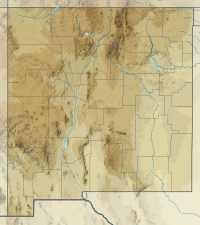Aden Crater is a small shield volcano located in Doña Ana County, about 25 miles (40 km) southwest of Las Cruces, New Mexico.[3] It is located in the northwest part of the Aden-Afton basalt field, which is part of the central area of the Potrillo volcanic field.[4][5]
| Aden Crater | |
|---|---|
 Aden Crater, New Mexico | |
| Highest point | |
| Elevation | 4,477 ft (1,365 m)[1] |
| Coordinates | 32°04′10″N 107°03′29″W / 32.0695412°N 107.058066°W[2] |
| Geography | |
| Location | Doña Ana County, New Mexico, U.S. |
| Topo map | USGS Aden Crater |
| Geology | |
| Mountain type | shield volcano |
| Volcanic field | Potrillo volcanic field |
| Last eruption | ca. 16,000 years ago |
A fossilized ground sloth,[6] now at the Peabody Museum, was found in a fumarole roughly 100' deep located on the SE portion of the crater rim. Several ground sloth coprolites were also recovered and were stored in the Geology department at UTEP.[7]
No volcanic activity at Aden Crater is known from historic times. The most recent known activity has been dated to roughly 16,000 years ago.[8]
The flows associated with the crater can be divided into two groups. The earlier lavas were more fluid and formed most of the flows to the east and south of the crater. These flows are characterized by inflation plateaus, formed when a solid crust begins to develop around a flow and the lava inflates the more ductile upper surface of the flow. The second group of flows were less fluid and accumulated closer to the vent to form the shield of the crater.[9]
Description edit
Aden Crater is an Icelandic-type shield volcano,[10] formed by repeated eruptions of very fluid olivine basalt. This has built a very low hill 3–4 miles (4.8–6.4 km) in diameter with slopes of just 3 to 5 degrees. The hill is topped by a crater about 1,400 feet (430 m) in diameter whose rim is composed of lava spatter that dips steeply into the crater (30 to 45 degrees). The crater itself contains a former lava lake, with a spatter cone and collapse pit in the southeastern part of the crater.[3]
The surrounding area has such features as explosion craters, collapse pits, spatter cones, and hornitos. Many of these are found on a low ridge extending to the southeast. A cluster of spatter cones is found southwest of the crater.[3]
A striking feature of the area around the crater is the presence of herraduras. These are horseshoe-shaped lava ridges with the open end pointing downslope. These are thought to have formed where lava was extruded through a fracture in the crust of an underlying flow, perhaps where gas accumulated and promoted fracturing.[3]
Geologic setting edit
The Potrillo volcanic field is located within the Rio Grande rift, where the Earth's crust is being stretched and thinned. The rift is characterized by deep sedimentary basins, recent faulting and volcanic activity, and unusually high heat flow upwards from the Earth's mantle.[11] Aden Crater is located atop the Aden rift, which runs northwest to southeast through the crater and is traced by collapse pits to the southeast. It is near the Robledo fault, a north–south fault of the Rio Grande rift. Both the rift and the fault are thought to have provided paths to the surface for erupting magma.[3]
References edit
- ^ "Aden Crater". ListsOfJohn.com. Retrieved February 10, 2014.
- ^ "Aden Crater". Geographic Names Information System. United States Geological Survey, United States Department of the Interior. Retrieved February 10, 2014.
- ^ a b c d e Hoffer, Jerry M. (1975). "A note on the volcanic features of the Aden Crater area, southcentral New Mexico" (PDF). New Mexico Geological Society Field Conference Series. 26: 131–134. Retrieved November 16, 2020.
- ^ Hoffer, Jerry M.; Penn, Brian S.; Quezada, Oscar A.; Morales, Monica (1998). "Qualitative age relationships of late Cenozoic cinder cones, southern Rio Grande rift, using cone morphology and LANDSAT thematic imagery: A preliminary assessment" (PDF). New Mexico Geological Society Field Guide. 49: 123–128. Retrieved November 13, 2020.
- ^ "New Mexico Volcanoes and Volcanics". USGS/Cascades Volcano Observatory. Retrieved February 10, 2014.
- ^ Sharp, Jay W. "Potrillo Volcanic Field". DesertUSA. Retrieved February 10, 2014.
- ^ Simons, Elwyn L.; Alexander, H. L. (January 1964). "Age of the Shasta Ground Sloth from Aden Crater, New Mexico". American Antiquity. 29 (3): 390–391. doi:10.2307/277883. JSTOR 277883.
- ^ Anthony E. Y.; Poths J. (1992). "3He Aden Crater, Rio Grande Rift, New Mexico, USA". Geochimica et Cosmochimica Acta. 56: 4105–4108. doi:10.1016/0016-7037(92)90022-b.
- ^ DeHon, R.A.; Earl, R.A. (2018). "The Aden lava flows, Doña Ana County, New Mexico" (PDF). New Mexico Geological Society Field Conference Series. 69: 197–202. Retrieved March 11, 2021.
- ^ De Hon, René A.; Earl, Richard A. (Spring 2018). "Reassessment of features in the Aden Crater lava flows, Doña Ana County, New Mexico" (PDF). New Mexico Geology. 40 (1): 17–26. Retrieved December 5, 2020.
- ^ Padovani, Elaine R.; Reid, Mary R. (1989). "Field guide to Kilbourne Hole maar, Dona Ana County, New Mexico". New Mexico Bureau of Mines and Mineral Resources Memoir. 46: 174–185.
